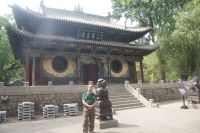In effect, the class ended when we arrived back in Beijing on Friday. We all had a free afternoon and evening to do last minute things—whether it was visit the zoo to see pandas, the pearl market to buy copies or real pearls, or to sample the night life (my recommendation was the Banana club. “did you like it Hoyt?” “No, but that means you will.”)
I did a few things I wanted to do. I went out for lunch with our guide, who asked whether I had ever eaten donkey, which he said was a Beijing specialty. Check that off my list of things to do. He said he’d had only one other tour leader sample the dish, and that person was lukewarm. I’d do it again—especially if any of those burros at Philmont give me a hard time.
We were near Liulizhang, which used to be the scholar/artist street. It’s still quaint, but in the current effort to build tourism, is a mix of older buildings built to look old, and older buildings that are. I stopped in to the tea shop I’ve frequented for seven years, the owner reminded me, and asked about my former student, JR Glenn, who has been there with me several times. I couldn’t leave without buying my favorite tea, liqi hong, a black tea flavored with lichee. I have never found it in the United States.
There was one other place on my itinerary—the Summer Palace built by 

Qianlong that was destroyed in 1860; I had been there only once. It’s on the outskirts of the city, but Beijing is fairly easy to navigate (thank you 2008 Olympics!) with 14 lines and a 30 cent fee for busses or subways. The buildings were mostly European style, and made of stone. The rubble remains as a haunting reminder of what happened to China during its century of humiliation. There were lakes as well, a legacy of Kangxi’s trips to the South, and especially the storied gardens of Suzhou and Hangzhou, which shaped the construction of the summer villa we saw at Chengde.
For a last meal with my colleague Ruth Ann, we went to nearby Wangfujing street, the “Michigan Avenue” of China. Passing through food street with its vendors selling everything from scorpion on a stick to dumplings, passing the old Catholic church, rebuilt after being destroyed by the Boxers (where a large crowd had gathered doing line dancing on Friday night), we went to Quanjude, the largest roast duck chain in the city. The hotel recommended it, and responded in the positive when I asked whether Chinese ate there (or whether it was primarily a tourist attraction). Beijing does attract tourists, Chinese and foreign, but we were the only Westerners in the restaurant.
At 4:30 am, I bade farewell to my 14 traveling companions, as they boarded the bus to the airport.
And my adventure alone began. I got a bullet train to Taiyuan. It’s around 300 miles southwest of Beijing—and it took 4 hours to get there. For those of you who have been on Chinese trains, you should be astonished—the ordinary train takes 8 hours. The cost was around $25!
Taiyuan is not a tourist destination, being an old city that has more history than historical artifacts, and is currently a center of heavy industry. We did 

see two interesting sites, nonetheless. One was a temple dedicated to a general, which had a 3200 year old tree, and some unusual construction including a cross bridge, with a Daoist half and a Buddhist half. The other was the home of a rich family that had business scruples (Confucian in origin, like treating  people fairly) and moral scruples (no concubines), and lasted as a wealthy family for five generations.
people fairly) and moral scruples (no concubines), and lasted as a wealthy family for five generations.
The compounds (two generations added to the construction, and included a stage for performing Shanxi opera) have been turned into a museum to showcase local customs and art, as well as to tell the story of the Qiao family. The wealth initially came from making bean curd (tofu), and wound up as banking/trading operation with locations all over China (except Gansu and Yunnan, I believe). The family housed Cixi when she fled Beijing after the 8 armies suppressed the Boxers, and she gave
wealth initially came from making bean curd (tofu), and wound up as banking/trading operation with locations all over China (except Gansu and Yunnan, I believe). The family housed Cixi when she fled Beijing after the 8 armies suppressed the Boxers, and she gave  them presents in return, including the right to call the house the best courtyard in China (sounds like something the Chamber of Commerce would designate); they gave her a month lodging, 300000 tales of silver, and apparently greased the wheels of the successors, which kept the house intact until the family fled the Japanese in 1937.
them presents in return, including the right to call the house the best courtyard in China (sounds like something the Chamber of Commerce would designate); they gave her a month lodging, 300000 tales of silver, and apparently greased the wheels of the successors, which kept the house intact until the family fled the Japanese in 1937.
Rather than stay in Taiyuan, my guide took me to Pingyao for two evenings, and that’s a different blog and a very different experience. I’ll send this when I can. Pingyao is an “ancient city” surrounded by a Ming dynasty wall, and minimum amenities. I’d say it’s like Lijiang in Yunnan, but none of you have been there, so I’ll tell you about it after I’ve toured it.